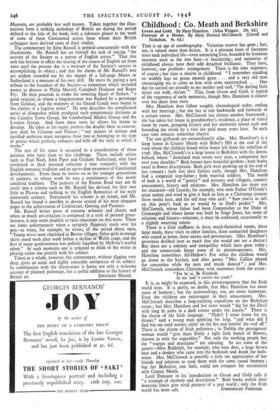Planned Patronage
From Sickert to 1948. The achievement of the Contemporary Art Society. Commentary'by John Russell. (Lund Humphries. 18s.) THIS elegantly-produced and well-illustrated volume seems to have been designed as a kind of super-" souvenir programme" for the activities of the Contemporary Art Society. It not only provides, for those who are already members of the Society, a convenient and attractive reminder of achievement during the first thirty-eight years of its life, but it presents a statement of aims which, it is hoped, may bring others into the fold as subscribers. It is thus partly propa- gandist in aim. The -reproductions have been chosen from among the more notable acquisitions made by the Society since its founda- tion in 1910. Many of them are as familiar as Sickeres Ennui (Tate • Gallery), or the fine Maillol Woman with a Necklace, now on view in the exhibition of sculpture in Battersea Park. Others, such as the distinguished group of prints and drawings by contemporary foreign
artists which have been presented by the Society to the British Museum, are probably less well known. Taken together the illus- trations form a striking anthology of British art during the period defined in the title of the book, with a sideways glance at the work of some of those Continental artists from whom their British colleagues have derived some of their vitality.
The commentary by John Russell is printed concurrently with the illustrations. Mr. Russell has set himself the task of tracing "the activity of the Society as a patron of English artists." That this task has become in effect the tracing of the course of English art from 1910 until the present day is a measure of the Society's success in accomplishing its object ; and that the claims of Mr. Russell's text are seldom crowded out by the impact of a full-page Moore or Sutherland is a measure of his own skill. He starts by paying a just tribute to the founders, of the Society—a committee which included names as diverse as Philip Morrell, Campbell Dodgson and Roger Fry. He then proceeds to evoke the towering figure of Sickert, "a great original, in whom a longshoreman was flanked by a personage from Goldoni, and the manners of the Grand Conde were found in the clothes of a fugitive ostler." He next describes the complicated series of demarches which produced such symptomatic divisions as the Camden Town Group, the Cumberland Market Group and the London Group. And from these roots he allows his theme to develop. He takes as his major premiss the double blow to conven- tion dealt by Cezanne and Picasso ; "any painter of serious and justified ambition must recognise these two as belonging to the type of genius which perfects, exhausts and kills off the style in which it works."
The rest of his space is occupied in a consideration of those painters who have risen to this challenge. These include artists such as Paul Nash, John Piper and Graham Sutherland, who have combined in their personal solutions a true sympathy with the English romantic tradition and an up-to-date awareness of Continental developments. From them he moves on to the younger generations of painters, in whose work he sees a continuance of this newly canalised tradition. The painters of the Euston Road may not fit easily into a scheme such as Mr. Russell has devised, for they owe little to Picasso and nothing to the English Romantics of the early nineteenth century. Fortunately his scheme is no tyrant, and Mr. Russell has found it possible to devote several of his most eloquent pages to the achievement of Coldstream, Gowing and Pasmore.
Mr. Russell writes prose of extreme urbanity and charm, and when so much art-criticism is composed in a style of pointed grace- lessness, it may seem churlish to raise objections on this score. There are times unfortunately when a sprightly flippancy steals over his pen—as when, for example, he writes, of the period about 1910, "Young wives were cherished in Breton villages, fisher-girls in orange skirts stood week after week before a skyline of Welsh crags, and the first of many gentlewomen was politely liquefied by McEvoy's tearful talent." At such moments one is tempted to think of the writer as playing rather too prettily with his subject.
Taken as a whole, however, the commentary, without digging very deep, gives an acute and highly enjoyable conspectus of its subject.
In cornbination with the illustrations- it forms not only a welcome account of planned patronage, but a useful addition to the history of



































 Previous page
Previous page